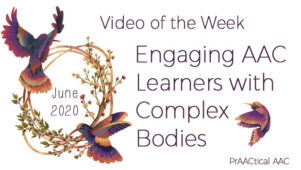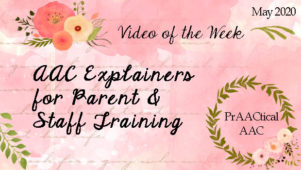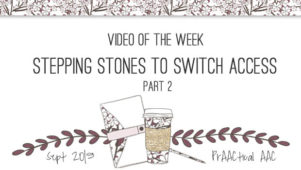Talking About Talking

 We gesture. We write with pencils and pens. We write with laptops, desktops, and tablets. We chat in person, on our phones, on iDevices, and on computers. In short, we all ‘talk’ in many ways. Having cerebral palsy, ASD, or apraxia doesn’t lessen the need to communicate in different ways. There’s nothing ‘special’ about needing a variety of tools to express yourself. Using multiple modes of communication is an accepted treatment standard for individuals who have significant communication difficulties. Just like it is for the rest of us. So having access to a variety of different tools is not something ‘extra’ that we provide only for people with special needs. So, no more moaning and groaning about providing access to a variety of communication tools, okay, world? Let’s just get over that and move on.
We gesture. We write with pencils and pens. We write with laptops, desktops, and tablets. We chat in person, on our phones, on iDevices, and on computers. In short, we all ‘talk’ in many ways. Having cerebral palsy, ASD, or apraxia doesn’t lessen the need to communicate in different ways. There’s nothing ‘special’ about needing a variety of tools to express yourself. Using multiple modes of communication is an accepted treatment standard for individuals who have significant communication difficulties. Just like it is for the rest of us. So having access to a variety of different tools is not something ‘extra’ that we provide only for people with special needs. So, no more moaning and groaning about providing access to a variety of communication tools, okay, world? Let’s just get over that and move on.Good interventionists know that AAC is much more than a piece of technology. We no longer expect that one tool or strategy will be sufficient to meet the sum total of one’s communication needs. Instead, we develop a constellation of tools and strategies that work to complement each. Multimodal communication allows us to communicate in the way that best fits the context.
Laurel is a perfect example of a student whose communication system is multi-faceted. It has evolved over time to include her natural speech (about 10 words), about a dozen sign approximations, a few gestures, a high tech AAC device, pictures schedules, communication boards, shared classroom communication aids and, most recently, an iPad with AAC apps. Together, they allow her to communicate at a linguistic level. She uses some of these better than others, but is learning to be more independent and effective with each of them. Laurel is a multimodal communicator. She talks in many ways.
Multimodal communication is nothing new. Remember the Total Communication classrooms from decades past? Well, they never really left. Good teachers and SLPs have continued to encourage children to communicate in a variety of ways.
In her classroom, Laurel uses a gesture (wave) and her natural speech to greet friends and her iPad to give them a message (e.g., “I have something to show you”). She uses her iPad to tell her teacher, ‘Grandpop,’ in morning meeting so that the group knows she had a visitor the previous evening. Laurel continues to use her iPad and communication device throughout the day to say single words, short sentences, and longer, pre-programmed messages (e.g., “Use a silly voice!”; “I need a break,” “See ya later, alligator”). She tends to use her high tech SGD for individual activities, and the iDevices when portability is an issue. The teacher also offers her shared classroom communication boards and devices with special vocabulary needed for the activities at hand. For the most part, though, Laurel is encouraged to use her personal tools as often as possible.
At the same time, adults are using these AAC tools and others when they talk to Laurel. The aide points to picture symbols on a communication board when telling Laurel what to do in the activity, for example. The teacher uses the high tech device while talking to Laurel when they are sharing a snack. The SLP shows Laurel the steps to an activity using a task schedule (aka activity schedule or mini schedule).
Does it confuse Laurel to use multiple communication tools and strategies? Not at all. She doesn’t seem to have any difficulty to understand that each of these things have something to offer. At this stage of her learning, she needs a good deal of help no matter what she is using. Using multiple forms of communication seems to be more of a challenge for the interventionists.
The bottom line is that we all use many ways of communication. Laurel and other folks with AAC needs are no different in that respect.
Filed under: PrAACtical Thinking, Strategy of the Month
Tagged With: access, apraxia, iPad, modes of communication, tech, visual schedule
This post was written by Carole Zangari





4 Comments
Dear Carole,
It’s so nice to see that you’ve figured it all out!
Thanks, Elgar! I’m working on it.
Hi Carole! I’m a grad student currently aspiring to be an SLP and I just wanted to let you know that this blog post is so powerful in helping others understand the acceptance of AAC in everyday life! Thank you for sharing your thoughts on such an important point!
Thanks for those kind words, Tyler. I’m always thrilled to hear from grad students who are interested in knowing more about serving people with complex communication needs. So glad that you’re exploring this area of clinical practice!